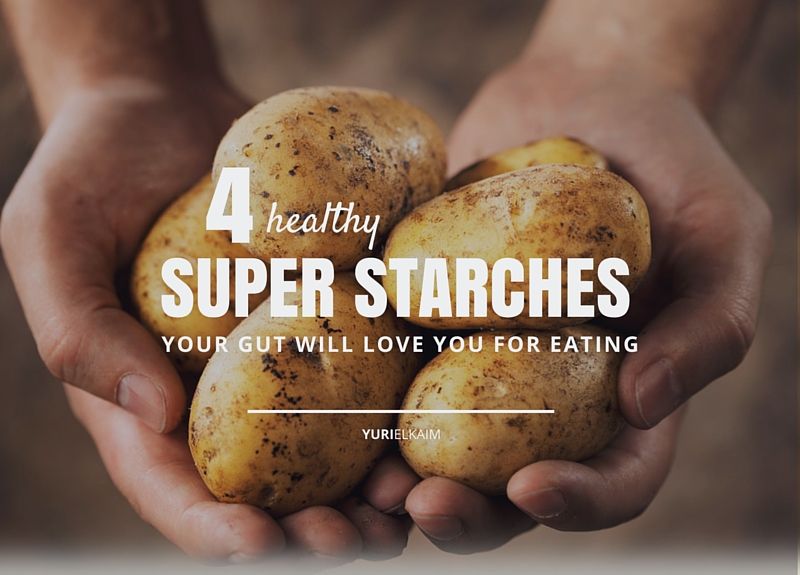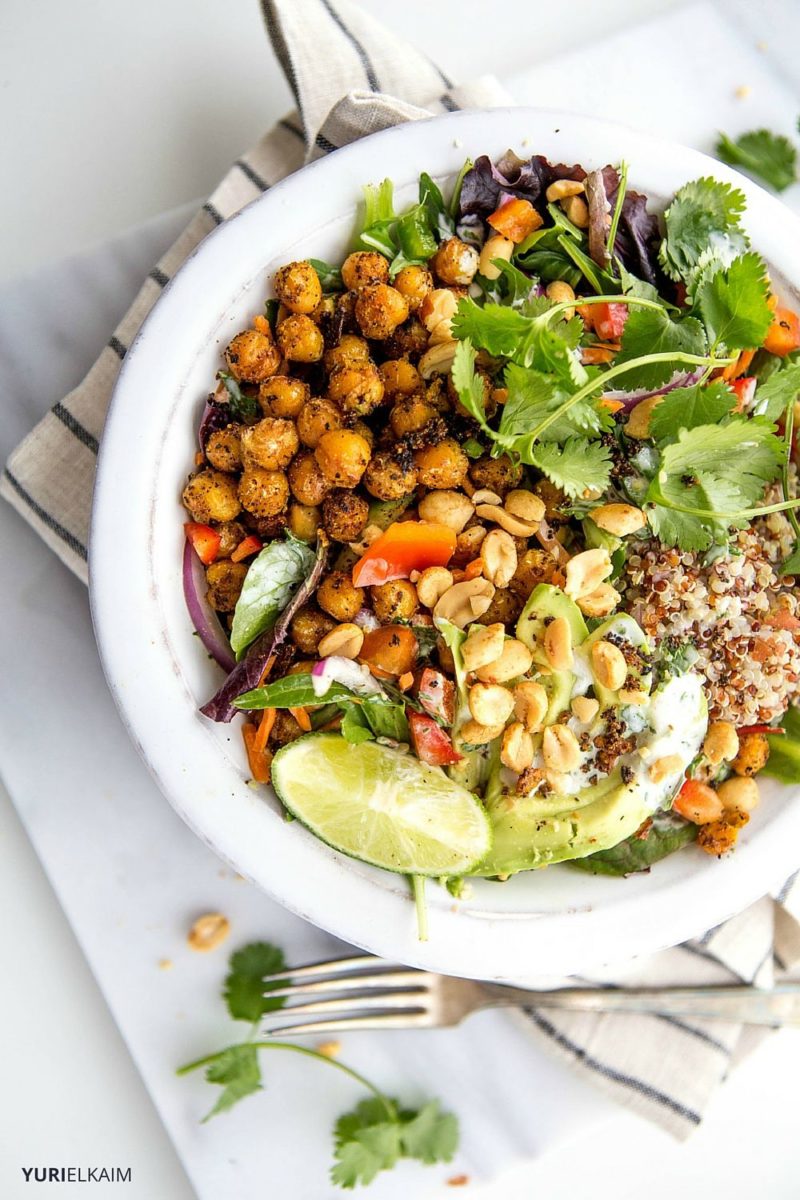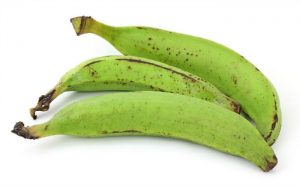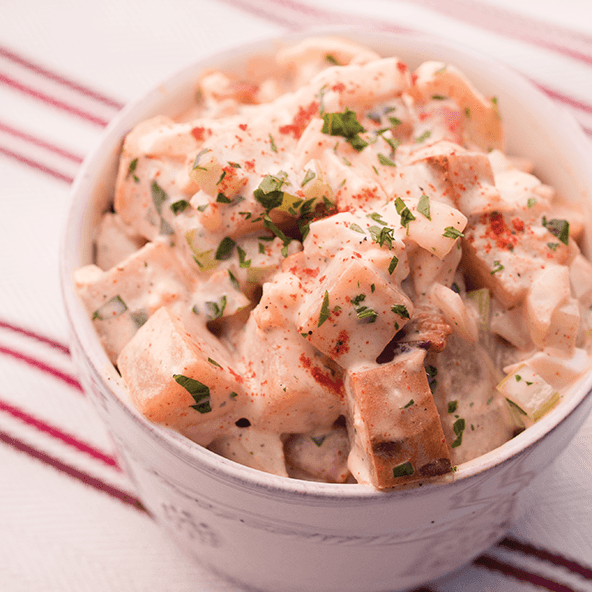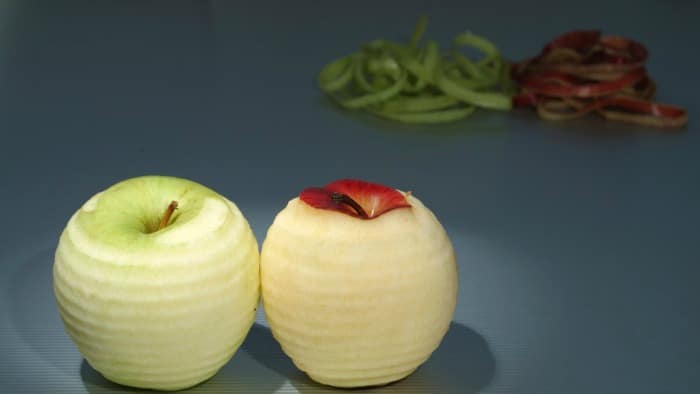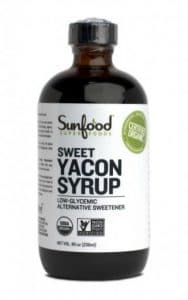In this article
When was the last time you heard starch being called the most important nutrient for your gut?
It’s kind of ironic because a lot of people actively avoid starches, thinking they’ll instantly gain weight and get a bigger belly.
But now healthy starches like brown rice, sweet potatoes, and even regular potatoes are gaining more attention as healthy starches your digestive system needs to be healthy. They might also help with weight loss.
Even advocates of low-carb diets are talking about these healthy starches and why your gut needs them.
Now, obviously these superfood healthy starches aren’t found in starchy junk food items like potato chips or white bread.
Instead, they’re found in unprocessed, whole foods: potatoes, beans, legumes, bananas, artichokes, and plantains.
These starches are considered healthy and important because they act as prebiotics, which means they feed the good bacteria — or probiotics— in your digestive system.
Healthy Starches = Happy Gut
Since roughly 70 percent of your immune system is found in your gut, it’s critical to your health that you have a thriving gut microbiome full of healthy bacteria – or probiotics – to help prevent the overgrowth of bad bacteria.
Too much bad bacteria can leave you more prone to a host of health conditions, including allergies and food sensitivities; digestive symptoms such as gas, cramping, and bloating; and in serious cases, autoimmune conditions (1).
Having a lack of friendly gut bacteria can even lead to mood disorders like depression and anxiety (2).
On the other hand, when your gut has a healthy supply of bacteria, you’re more likely to have plenty of energy, improved digestion, a happier mood, glowing skin, and a rock-solid immune system.
This is why getting prebiotics from our diet from healthy starches is so important, as they feed the good bacteria that help us feel our best.
Now, let’s take a look at four healthy starches that will make your gut happy and how you can easily include them in your diet to instantly make a difference in your health.
Healthy Starch 1: Resistant Starch
Resistant starch gets its name from being resistant to digestion, which means the human body can’t break it down.
Instead, it passes straight through the gastrointestinal (GI) tract, reaching the colon still intact. This is where the good bacteria that live in our colon begin to digest (or ferment) the resistant starch (3).
And not only do resistant starches feed the probiotics that form the foundation of our health, but the health benefits of resistant starches go one step further once they get broken down.
That’s because when the good bacteria in the colon begin to digest the resistant starch, they produce short-chain fatty acids. One of these fatty acid is called butyrate, which has been studied because it’s believe to protect the colon.
Some studies suggest that butyrate promotes colon health and prevents colon cancer. In fact, butyrate has also been studied as an effective nutrient for treating irritable bowel diseases such as colitis, especially when added to enemas (4).
Resistant starch can help control blood sugar and promote weight loss. Since resistant starch doesn’t go through complete digestion in our GI tracts as other foods do, it actually has no impact on blood sugar levels and even improves insulin sensitivity (5).
Resistant starch has earned the name “slimming resistant starch,” as it doesn’t upset blood sugar levels, which can trigger fat storage in the body when they fluctuate.
There are four primary types of resistant starch (RS): type 1, 2, 3 and 4.
RS Type 1
The most basic form of resistant starch is found most abundantly in cooked grains, seeds, and legumes. It’s characterized by having a thick cell wall that makes it impossible for the human body to break down.
If you include grains and legumes in your diet, you’ll be able to get type 1 resistant starch from your diet by incorporating them in recipes each week.
When it comes to grains, I recommend choosing gluten-free varieties like brown rice to avoid the intestinal inflammation gluten can cause (6).
Crispy Chickpea Thai Quinoa Bowl
If you’re in search of some recipe inspiration outside of “plain Jane” cold beans and rice dishes, here are a few of my RS 1-rich favorites:
- 5 Ingredient Black Bean Quinoa Burgers
- Crispy Chickpea Thai Quinoa Bowl
- Vegan Buddha Bowl With Sweet Sesame Brittle
RS Type 2
Unripe bananas, raw plantains, raw potatoes, and uncooked potato starch contain this type of healthy starch.
There are a few caveats when it comes to RS type 2.
First, you probably aren’t going to wake up first thing in the morning craving a raw plantain or a raw potato.
And second, it’s not digestible in its raw form, but when it’s been heated to high temperatures, the body can digest it. However, heating it means there will be nothing left to feed the colon’s good bacteria by the time it’s digested (3).
That’s why many people are beginning to include plantain flour or raw potato starch in their diets to obtain RS type 2.
Both varieties of type 2 resistant starch are virtually flavorless, which make them easy to mix in with smoothies – like this Healthy Gut Smoothie, and even cold soups. Using it this way means you can receive all of the health benefits from RS type 2 without having to chomp on a raw potato or eat a raw plantain.
The Healthy Gut Smoothie (Carrot Cake)
You can find raw potato starch at most health food stores or online. Bob’s Red Mill makes gluten-free unmodified potato starch and can be found at most regular grocery stores and health food stores.
Plantain flour is less common on grocery store shelves in North America since it’s typically imported, but can be found at some ethnic food stores or specialty food stores.
Three: RS Type 3
Also called retrograded starch, this form of resistant starch is found in cold potatoes, grains, and beans. But unlike type 1, RS type 3 is only found in foods that have first been cooked and then cooled down by freezing or refrigeration.
This is because the RS type 3 can easily be digested when heated (3).
And in case you’re wondering, you can cook, then cool, and then re-cook a food— and it will still maintain the retrograded RS.
Classic Paleo Potato Salad via Well Fed
That means you don’t have to eat the food cold, although I would advise against re-heating a cooked-and-cooled RS food at scorching hot temperatures. Be sure to keep the heat relatively low.
Like I said, type 3 resistant starch is found in cold potatoes, grains and beans. Doesn’t that sound like the perfect reason to eat leftovers for the rest of the week? Here are a few recipes that incorporate these ingredients once they’ve been cooked and cooled:
Four: RS Type 4
This is a synthetic form of resistant starch, chemically produced and most commonly found in Hi-maize resistant starch, which is derived from corn.
Since corn is one of the world’s most common GMO crops, I don’t recommend RS4 as a go-to source for obtaining resistant starch.
Instead, I suggest focusing on foods that provide type 1, 2, or 3 resistant starch, like gluten-free grains, seeds, beans, legumes, and potato starch.
How Much Resistant Starch?
We’re still not quite sure exactly how much resistant starch you should have each day. However, most studies have reported using anywhere between 15 to 30 grams of resistant starch when determining its health benefits (7).
Regardless of how much resistant starch is being used in the studies, everyone’s body is different, which means we’ll all respond differently to changing intakes of various nutrients.
Some people experience digestive symptoms like gas and bloating when they increase their fiber intake, especially if they have been eating a diet high in processed foods.
That’s why it’s a good idea to slowly add new foods to your diet, and then gradually increasing your intake based on how your body reacts.
Healthy Starch 2: Inulin
Found in plants, inulin is part of a group of polysaccharides (sugar molecules) called fructans.
Just like resistant starch, inulin travels through your digestive system and makes its way to your lower bowel, where it feeds the friendly bacteria living there.
In particular, inulin has been shown to feed the healthy strain of gut bacteria known as bifidobacterium (8). Inulin is a soluble fiber and has been shown to slow digestion and balance blood sugar levels (9).
One of the richest sources of inulin is chicory root, which you may have seen on food labels as an ingredient. Chicory root is commonly added to boxed foods like granola or cereals to help increase the fiber content, and is widely recognized as a nutrient needed for health.
It’s best to purchase chicory root and add it to your own homemade granola or protein bars. In fact, inulin is an essential ingredient in my All Day Energy Bars, which are one of the most nutritious varieties of energy bars available today.
And while chicory root is by far the best source of dietary inulin, you can also get smaller amounts of inulin by including the following foods in your diet:
- Leeks
- Asparagus
- Jerusalem artichoke
- Onions
- Dandelion root
- Yacon root
- Garlic
- Oats
Since you might not be eating Jerusalem artichokes or yacon root every day, you can also take inulin as a dietary supplement.
That being said: it’s always best to check in with a qualified healthcare practitioner before adding any new supplements to your diet. In my personal opinion, it’s still best to get inulin from food sources like chicory.
Many people enjoy using a blend of chicory root and dandelion root as a caffeine-free substitute for coffee, which can be found at any health food store. Ground chicory can also be added to homemade healthy snack recipes.
Increasing the fiber in your diet can initially cause or worsen existing digestive symptoms as it’s fermented by the bacteria in your colon.
Always pay attention to your body’s signs. If you experience gas, bloating, and abdominal cramping, be sure to add healthy starches to your diet slowly and then gradually increase the amount, as long as you aren’t experiencing digestive symptoms.
Healthy Starch 3: Pectin
You can find pectin in berries, citrus fruits, plums, and apples. If you’ve ever made jam from these fruits, it’s because pectin forms a gel-like substance that acts as a natural thickener and binder.
But pectin is much more than an ingredient that can help you win in the “best jam” category at the county fair.
Pectin makes the list of healthy starches because it’s a soluble fiber that has been shown to act as a prebiotic that feeds the good bacteria in your colon (3).
And one of the most common nutrition tips for relieving constipation is to eat apples, because of their high pectin content.
The best way to add pectin in your diet is by eating it in whole-food form, from berries, apples, and citrus fruits.
I recommend buying organic fruits whenever possible, especially when it comes to apples. Not only are non-organic apples one of the most-sprayed crops, but the highest concentrations of pectin are found in the skin of apples, which is also where toxic pesticide residue lingers.
If you want to include pectin in your own recipes, it can be purchased in powdered form at your local grocery store, although the quality of the ingredients is questionable.
Many forms of store-bought pectin are said to be derived from genetically modified (GM) ingredients, which I recommend avoiding them due to potential health risks, including cancer (10).
Instead, you can easily make pectin at home by boiling organic apples with lemon juice and water.
And pectin doesn’t have to be limited to jam recipes. You can also add this healthy starch to snack recipes, such as this Chocolate Chia Seed Pudding recipe.
Healthy Starch 4: Oligofructose
Oligofructose is a subgroup of the polysaccharides found in inulin. Dietary sources of oligofructose include artichokes, bananas, chicory root, and onion.
The only difference between oligofructose and inulin is their chain length. Otherwise, oligofructose has been proven to share the same health benefits with inulin and acts as a prebiotic to feed the good bacteria in your colon (11).
Oligofructose tastes sweet but doesn’t provide the body with any calories since it isn’t digested or absorbed in the GI tract. This is why many natural sweeteners or syrups that contain oligofructose (such as yacon syrup) are safe to use for those who have blood sugar imbalances or follow a low-carb diet.
You can find oligofructose at your local health food store or online in powdered form as a prebiotic powdered supplement. You can add it to your smoothies or beverages, or include it in your favorite healthy baking recipes, like these Gluten-Free Protein Brownies.
List of Healthy Starches to Eat
As you can see, these 4 healthy starches can do wonders for improving your gut health and protecting you against digestive disorders and colon cancer. When your gut bacteria are thriving, you’ll feel the difference in your health right away.
And if I can leave you with one more key piece of advice: Always be sure to increase your water intake along with your fiber.
Water helps fiber move through your digestive tract, and can prevent the initial onset of symptoms that can result from adding more fiber to your diet – such as gas, bloating, and abdominal cramping.
Practically speaking, when adding fiber to your diet, drink two glasses of water first thing in the morning instead of one. Also add an extra glass of water in the afternoon and another one before you go to bed.
As always, listen to your body when introducing superfood nutrients to your diet and follow its cues. It won’t steer you wrong.
Feel Better Tomorrow
Feeling bloated, lethargic, and like you need a “cleanse”?
Bust sugar cravings, restore youthful energy, and drop belly bloat with my FREE 1-Day Detox Plan.
Eat mouthwatering meals that will get your body back on track. Get it right now by clicking the banner below!

